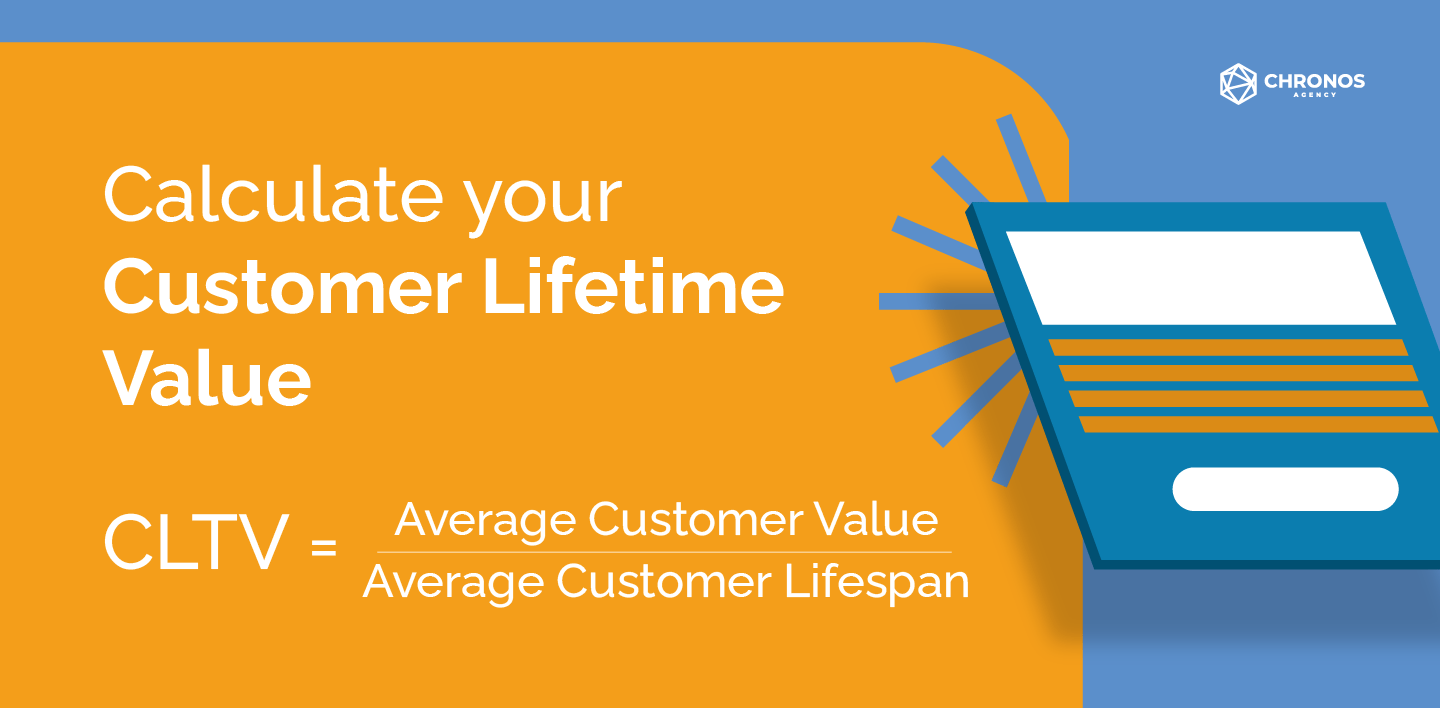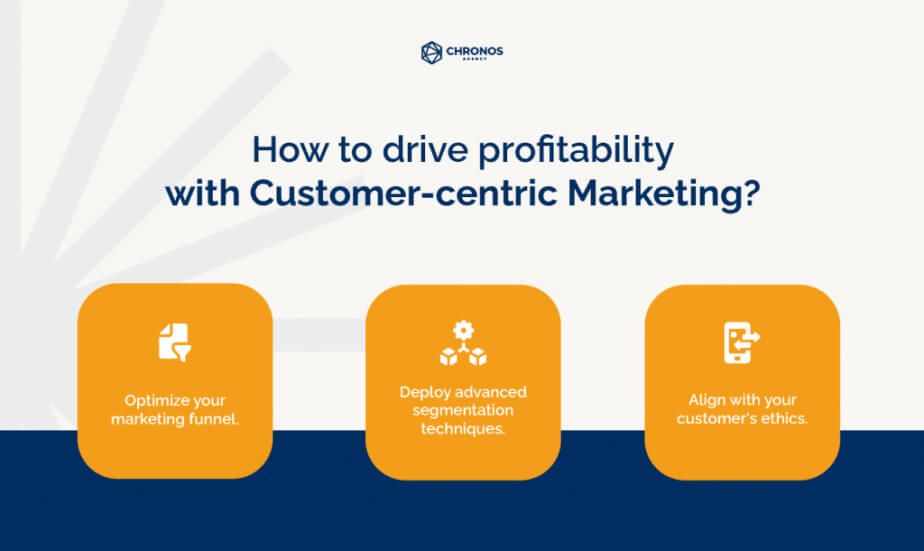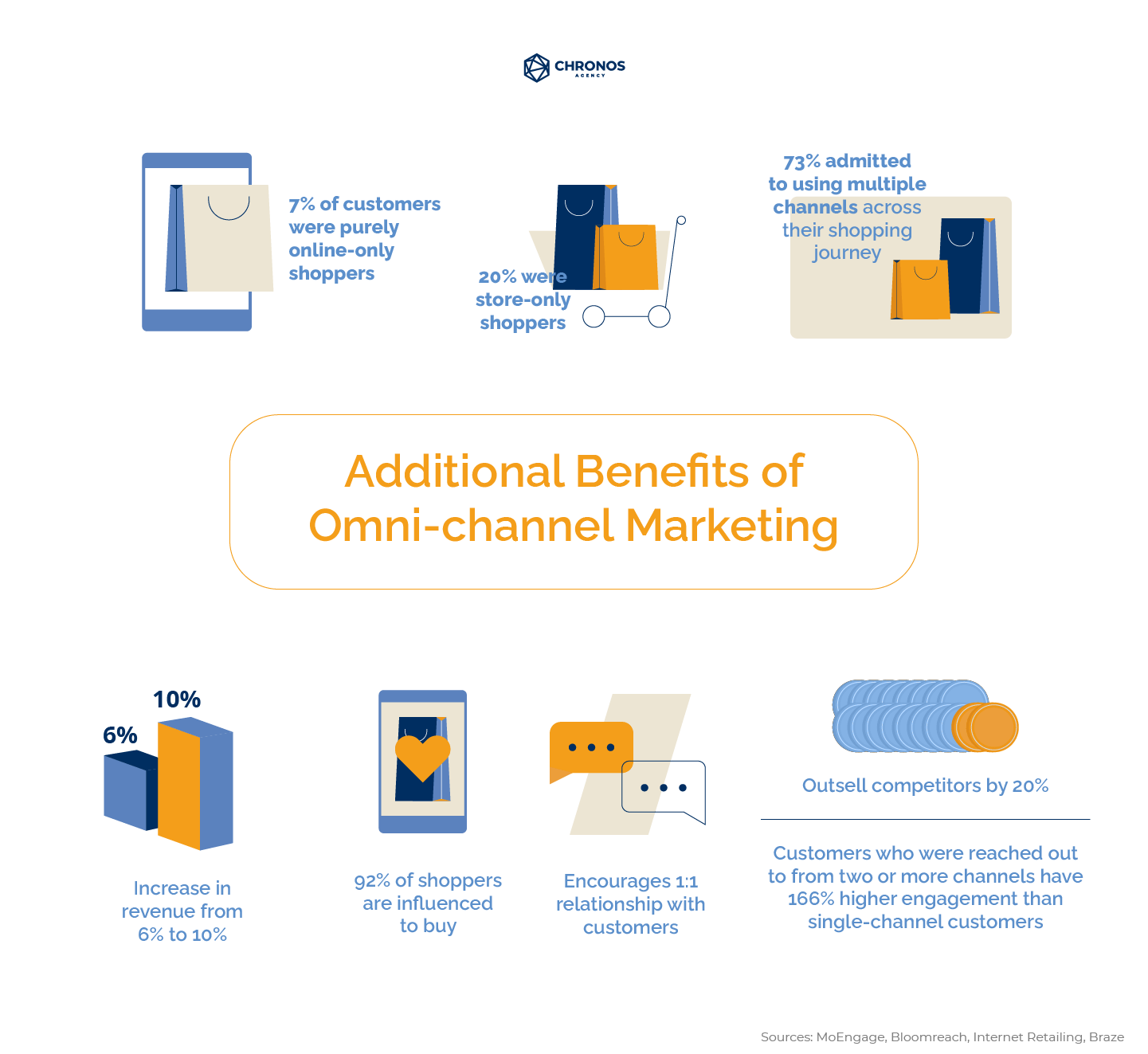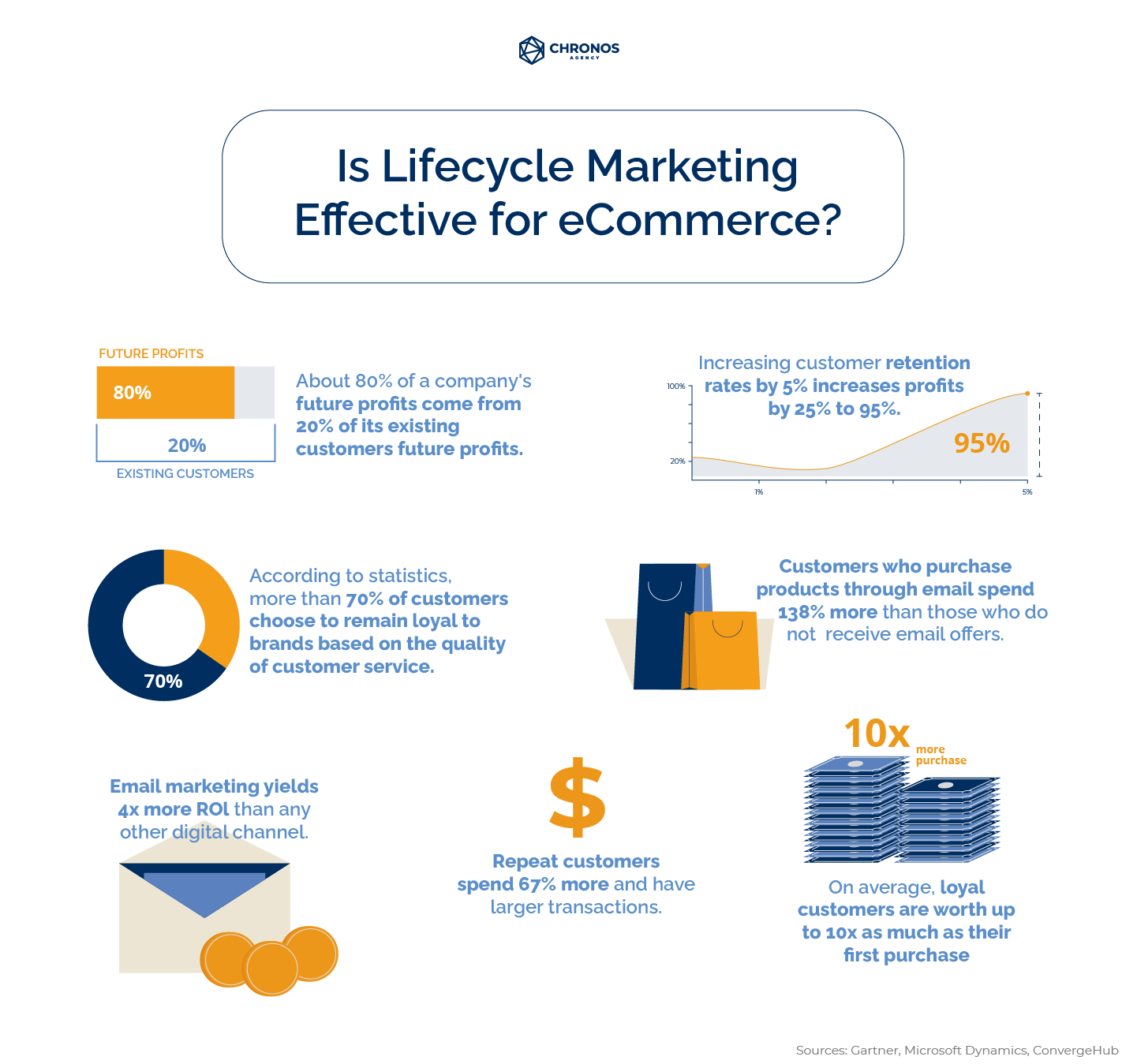How do you achieve long-term and sustainable eCommerce success without burning out your business? Look no further than lifecycle marketing.

Customer acquisition focuses on investing in strategies and campaigns required to convert prospects into customers. The keywords there are “gaining new customers.” This means starting from scratch every single time whenever you try winning over prospects to your store. In short, it would cost your store 5x more to attract new customers. So in this context, more doesn’t always mean merrier. Customer retention, however, focuses on retaining your current customers and further improving their projected value to your store.
So, not only is customer retention more cost-efficient compared to customer acquisition, but it also contributes to your store’s sustainability and longevity. With that said, your efforts should now cater to your existing customers. What’s next? It’s time to calculate the practical value your customers can bring to your store. Customer lifetime value (CLTV) is a critical metric that can help you optimize your customer retention strategies. Calculating CLTV can give you insight on the future revenue your customers can potentially generate for you.

You just need two things: Your average customer value and your average customer lifespan. Then just put them through this formula:
CLTV = Average Customer Value x Average Customer Lifespan
What does that have to do with your store growth? Tracking your CLTV can help tell you how effective your marketing efforts are at winning over loyal customers.
Other things measuring CLTV can help you determine are
You have a wide range of customer retention strategies to choose from that can help you improve your CLTV. To help save time, let’s bundle these strategies into an easy-to-digest topic called lifecycle marketing.
How can I drive profitability with customer-centric marketing?
If you’re looking for long-term and sustainable eCommerce success, then lifecycle marketing are the keywords to help you get started. It involves leveraging strategies that focus on your customers’ needs and preferences.
This would mean diving into the nitty-gritty of customer data. You’ll need to gain a much deeper level of understanding of your target audience and center your marketing around them.
So, what are some key actionables you can do to get started with customer retention?

Do you feel your current segments are only scratching the surface of your target market? Basic segments can only get you so far—and that’s where advanced segmentation can help you push the envelope!
Do you feel your current segments are only scratching the surface of your target market? Basic segments can only get you so far—and that’s where advanced segmentation can help you push the envelope!
You must dive deeper than basic demographic data. You’ll have to start looking more into your target audience’s online purchase behavior. Here’s a quick overview of the advanced segments you should consider:
Do you feel your current segments are only scratching the surface of your target market? Basic segments can only get you so far—and that’s where advanced segmentation can help you push the envelope!

How Can I Drive Profitability with Customer-centric Marketing?
Direct marketing channels are great for bringing your products forward to the customers who need them. Usually, you would include CTAs with these product highlights to get your customers to act or take the next step in their customer journey.
As you can already tell, direct marketing works best when centered around valuable customer data. After all, the best way to attract prospects and convert them into buying customers is to feature products that fall under their range of interests.

Here are some examples of direct marketing channels you can leverage:
Do you feel your current segments are only scratching the surface of your target market? Basic segments can only get you so far—and that’s where advanced segmentation can help you push the envelope!
Do you feel your current segments are only scratching the surface of your target market? Basic segments can only get you so far—and that’s where advanced segmentation can help you push the envelope!
You must dive deeper than basic demographic data. You’ll have to start looking more into your target audience’s online purchase behavior. Here’s a quick overview of the advanced segments you should consider:
Paid advertising on the digital landscape helps you with product placement. When people search for a product, you can use paid ads to make sure search results put you at the top of the page. Better SERP (Search Engine Results Page) ranking can help you break through the noise of countless other stores offering the same products as you.
Other than that, investing in paid ads can help you—
There are two ways you can time your pop-ups. (1) Hard timers and (2) Scroll triggers. Hard timers are the most self-explanatory but are also, ironically, the hardest to nail the timings of.
“We observed the website of one of our clients and noticed visitors tend to leave their website after an average of 1 minute and 15 seconds without buying anything. So what we did was set their pop-up to appear just before their visitors leave.”
— Josh Chin
“We observed the website of one of our clients and noticed visitors tend to leave their website after an average of 1 minute and 15 seconds without buying anything. So what we did was set their pop-up to appear just before their visitors leave.”
— Josh Chin

We call it the lifecycle marketing power triangle, as it involves leveraging three marketing channels to make the dream work.
Do you feel your current segments are only scratching the surface of your target market? Basic segments can only get you so far—and that’s where advanced segmentation can help you push the envelope!
Do you feel your current segments are only scratching the surface of your target market? Basic segments can only get you so far—and that’s where advanced segmentation can help you push the envelope!
You must dive deeper than basic demographic data. You’ll have to start looking more into your target audience’s online purchase behavior. Here’s a quick overview of the advanced segments you should consider:
Also known as mobile push notification marketing. This marketing channel takes advantage of consumers’ mobile lifestyle. If you haven’t yet, having an app for your DTC store can serve as a lucrative asset. In our case, we’ve observed our client stores’ apps generating 7% of their overall revenue leveraging push notifications. What makes push notification marketing particularly effective is that it’s a permission-based marketing tool. Meaning, your target consumers would explicitly give your store’s app permission to send them promotional content.
You’ll have a source of high quality customers who show genuine interest in your brand and products. You can confidently send these customers promotional material and have more returns in the long run. Compare that to sending to random users who may or may not be interested in your brand in the first place.
So, why these 3 marketing channels, specifically? Email marketing specializes in digging deep into your target audience’s data. In turn, you send personalized messages and optimized content catered to your customer’s preferences. You can seamlessly integrate SMS with your existing email marketing framework.
There are two ways you can do this:
Finally, push notifications can help tie everything together. Recommend relevant products, minimize cart abandonment, and even engage with your customers more by sending educational content.
You don’t have to restrict yourself to this power triangle. In fact, we highly recommend you expand your customer reach by exploring other channels. And one of the best first-steps to broadening your customer reach would be social media.
These are the town squares of the internet community. Countless people from around the globe have social media accounts, even multiple accounts per person to accommodate multiple social media platforms.
Okay, but why SHOULD you expand into social media?
Different platforms are great at funneling together groups of people who share similar interests. These can already help you get a head start when connecting with your target audience.
Remember, social media is a channel filled with pools of prospects you can dive into. With that said, here’s a list of social media platforms your marketing efforts can zero in on:

Aside from being one of the top widely used social media platforms, it’s also pretty versatile when it comes to content and engagement. Simple engagement posts can help you connect with your target audience. From short one or two-liners giving your followers a quick ‘what’s up’, to longer posts where you share value-adding information about your brand.
Aside from being one of the top widely used social media platforms, it’s also pretty versatile when it comes to content and engagement. Simple engagement posts can help you connect with your target audience. From short one or two-liners giving your followers a quick ‘what’s up’, to longer posts where you share value-adding information about your brand.
Aside from being one of the top widely used social media platforms, it’s also pretty versatile when it comes to content and engagement. Simple engagement posts can help you connect with your target audience. From short one or two-liners giving your followers a quick ‘what’s up’, to longer posts where you share value-adding information about your brand.
Aside from being one of the top widely used social media platforms, it’s also pretty versatile when it comes to content and engagement. Simple engagement posts can help you connect with your target audience. From short one or two-liners giving your followers a quick ‘what’s up’, to longer posts where you share value-adding information about your brand.
Aside from being one of the top widely used social media platforms, it’s also pretty versatile when it comes to content and engagement. Simple engagement posts can help you connect with your target audience. From short one or two-liners giving your followers a quick ‘what’s up’, to longer posts where you share value-adding information about your brand.
Aside from being one of the top widely used social media platforms, it’s also pretty versatile when it comes to content and engagement. Simple engagement posts can help you connect with your target audience. From short one or two-liners giving your followers a quick ‘what’s up’, to longer posts where you share value-adding information about your brand.
If you’re not sure on how to properly set up your social media marketing, then don’t fret! there are social media marketing agencies out there in the digital space that can do the work for you seamlessly.
No need to go through the learning curve, just hire a team of experts!
What are the Key Differences?
On the other hand, omnichannel marketing involves leveraging your available channels and centering them around your target customers. Again, it’s all about shooting for that customer-centric approach in lifecycle marketing.
Omnichannel marketing works because you’re connecting with your customers and speaking in their language, regardless of their preferred platform.
You’re creating a seamless customer experience across your marketing channels. Enhance the customer experience by making all your channels feel like true extensions of your DTC store



Lifecycle marketing is responsible for the long-running and sustainable eCommerce success of many 7 to 8-figure brands.
Customer-centricity is key to future-proofing your DTC store.
Customer retention is more cost-efficient and overall presents a more long-term and sustainable growth solution for eCommerce businesses.
Leverage direct marketing channels to establish direct communication with your customers as well as bring forward products and services that they would be interested in.
Omnichannel marketing is important to help tie all your existing marketing channels together for a seamless and consistent customer experience.